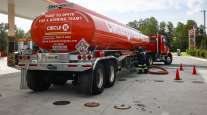Some Gas With That Sandwich? Convenience Dominates Fuel Market

Major oil companies have been steadily squeezed out of the U.S. retail gasoline business, where refueling your stomach has become as important as topping off your gas tank.
Motorists who once scoured American roadways for Exxon’s tiger or Texaco’s star now search for Buc-ee’s beaver or Wawa’s Canada goose. And millennials value the quality of food in their gas stations just as much as the price at the pump.
Now the two models are coming together, combining the strength of fuel brand recognition with new consumer preferences for a broader buying experience, and boosting profits in the volatile, competitive business of selling fuel to U.S. drivers.
“Irrespective of the operating model, the key to our growth plans is the brand,” said István Kapitány, executive vice president of retail for Royal Dutch Shell Plc, in a phone interview from London.
In the U.S., Shell has partnered with Alimentation Couche-Tard’s Circle K, allowing it to expand the market for its Shell-branded gasoline by pairing its loyalty rewards program with the second-largest convenience-store operator in North America. Exxon Mobil Corp. has similar arrangements with Circle K and 7-Eleven Inc.
It’s a one-two punch in brand recognition that allows each party to focus on its strengths, says Charlotte Huffaker, an Exxon spokeswoman.
“Exxon Mobil brings deep fuels marketing expertise and a world-class supply and transportation network,” she said. “The branded wholesalers build their businesses with local capital and are able to adapt to consumer preferences for convenience store options.”
Penny Margins
Selling cheap gasoline along America’s highways was never really Big Oil’s thing. Profits at the pump are limited to pennies on the gallon, margins more frequently seen in the grocery business than oil drilling. But with $38.7 billion in gasoline sales in July, according to the U.S. Census Bureau, there are a lot of pennies at stake.
As major energy companies whittled down their retail business through sales and franchises to focus on finding and processing oil, convenience stores and big box retailers swooped in, enticing customers with one-stop shopping that offered food and basic necessities alongside gasoline and diesel.
The five largest oil companies owned 0.4% of U.S gasoline stations in 2014, down from 1.9% in 2008, according to the latest data available from the National Association of Convenience Stores, or NACS. The majority of filling stations bearing the logos of iconic companies such as Exxon, Chevron Corp. and BP Plc actually are owned by individual entrepreneurs or convenience-store chains that have long-term supply contracts with one of the major oil companies.
No More Sunoco Tacos as Energy Companies Shed Gasoline Stations
As a result, convenience stores such as 7-Eleven and Sheetz Inc. pumped more than 80% of U.S. gasoline purchased in 2015, up from 59% in 1997, according to NACS. Big-box stores like Kroger Co., Wal-Mart Stores Inc. and Costco Wholesale Corp. sold much of the rest.
“There’s a shift in people buying gas based on the quality of the sandwich as opposed to getting a sandwich based on the price of gas,” said Jeff Lenard, vice president of strategic industry initiatives for NACS.
The percentage of people who say gasoline price determines where they refuel has fallen by 6 points since 2015, to 51%, in a NACS consumer survey published in March. Millennials split equally at 45% on the gas price versus food quality question, Lenard said.
“You can’t just have good gas prices,” said Billy Milam, president of RaceTrac Petroleum Inc., a Georgia-based convenience-store chain with about 450 outlets across the U.S. South, whose stores now offer Wi-Fi and other perks. “Back 20 years, we’d rarely talk about what we’d sell in stores, but it’s really taken root over the past 10 to 12 years and we had to reshape our business to make that possible.”
Food Focus
Chains like RaceTrac and QuikTrip, which has about 750 stores in 11 states from Texas to Nebraska, are modernizing stores and emphasizing customer service. QuikTrip’s website showcases pictures of fresh foods including made-to-order breakfast bowls, burritos, pizzas, sandwiches and flatbreads — not cheap gasoline. 7-Eleven highlights its Big Gulp and Slurpee drinks, and the Mid-Atlantic’s Wawa Inc. hawks hoagie sandwiches.
The focus on snacks over gas is probably what’s keeping the closely held chains profitable, said Joseph Leto, president of Energy Analysts International, or EAI, in Colorado, who noted that 20,000 convenience stores have closed since 2012.
“These stores were probably highly dependent on fuel margins and not in-store sales,’’ Leto said of the shuttered retailers.
Big Box retailers also got into the act, with Wal-Mart and Costco building gasoline stations in the same parking lots as their stores. About 28 fueling sites a month were added to big-box store locations in the past year, according to EAI data.
Separate Priorities
Oil companies that have remained in the retail fuel market are also thinking beyond gasoline. Refiner Marathon Petroleum Corp. plans to spend $380 million on its Speedway stores this year to expand private-label products, CEO Gary Heminger said in a June presentation at the JPMorgan Energy Equity Investor Conference in New York.
Billionaire investor Paul Singer’s Elliott Management Corp. has different ideas, wanting Marathon to split its retail and refining business to get more value from both. It’s forced Marathon into a months-long strategic review of the business, which should be complete next month.
QuikTrip, a high-volume operator which says it handles 2.5% of all U.S. gasoline sales, is looking for transactions inside its brick-and-mortar stores to make up a quarter of its revenue.
“We wouldn’t be investing our money on in-store sales if we didn’t think that was the future,” Michael Thornbrugh, a spokesman in Tulsa, Oklahoma, said by phone.
With assistance by Joe Carroll




